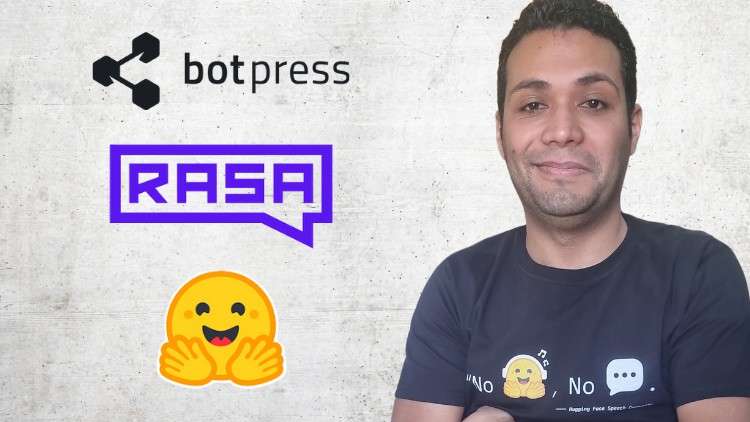
All you need to develop your next AI Chatbot using Open-Source tools like Botpress, Rasa, Transformers and FastAPI
What you will learn
Developing Chatbots using Open-Source tools like Botpress, Rasa and Transformers. No cloud based solutions.
Understand all of the Chatbot developing pillars like intent-detection, entity-recognition, conversation flow and more.
Learn the Concepts of Prompt Engineering using LangChain, ChatGPT and HuggingFace
Develop Neural Networks models to detect entities and Recognize entities in the user messages.
Integrate with third parties and APIs to develop mature chatbots with live data.
Develop web applications using fastAPI to support the chatbot services.
Learn via developing a set of real-world chatbot projects.
Description
Are you ready to learn how to build powerful and AI-supported chatbots from scratch?
there are a lot of courses out there that teach you how to develop chatbots. So what makes this course DIFFERENT?
- We’re NOT going to use any cloud-based chatbot solutions like Dialogflow, IBM Watson, or Microsoft Azure. Instead, we’ll be focusing on free and open-source technologies that are just as robust and powerful.
- We’re NOT just going to talk only about the basics of chatbot development. We’re going to dive deeply into this world.
- This course is full of project-based tutorials. A lot of techniques will be derived via developing a set of chatbot projects
Chatbots are everywhere and are becoming an increasingly important part of our daily lives. They’re used for a wide range of applications, from customer service to online shopping, and they’re only getting more advanced and sophisticated.
In the course, we delve into the different types of chatbots and their use cases, including rule-based chatbots, AI-powered chatbots, and conversational AI. We also cover the various technologies and platforms that are used to build chatbots, such as natural language processing (NLP), machine learning (ML), and chatbot development open-source projects like Botpress, Rasa, Transformers, langChain, fastAPI, Docker, and more.
In this course, you will learn:
- How to Setup Your Development Environment Tools
- How to Install and start your first Botpress project
- You will Understand what the conversation flow studio is
- Develop the different types of chatbot response templates
- You will learn how to Integrate with third parties and APIs to provide external information for users
- How to Develop a QnA chatbots
- Understand the problem intent detection and how to solve it using either rule-based or neural network techniques
- How to recognize entities in the user message and how to fill the slots.
- How to collect user data and forward them to an external API or store them in a database.
- How to develop your Rasa Chatbot Assistant models
- How to integrate Botpress with Rasa Chatbot Assistant
- How to develop a fastAPI app to serve your AI projects
- How to integrate your chatbot with popular messaging platforms like Facebook Messenger and Telegram
- How to use the modern Large Language Models (LLMs) like OpenAI to support your chatbots
- Learn all the basics of building a robust application using ChatGPT and open-source Large Language Models
- How to use Drage-Drop UI Tools like Flowise to Develop LLM chatbots
- How to use LLMs to develop AI Engines and Chatbots
- More ..
By the end of the course, students will have a comprehensive understanding of the current state of chatbot technology and how it is being used in real-world applications. This knowledge will equip students with the skills and confidence to embark on their chatbot projects and contribute to the rapidly evolving field of conversational AI.
Content